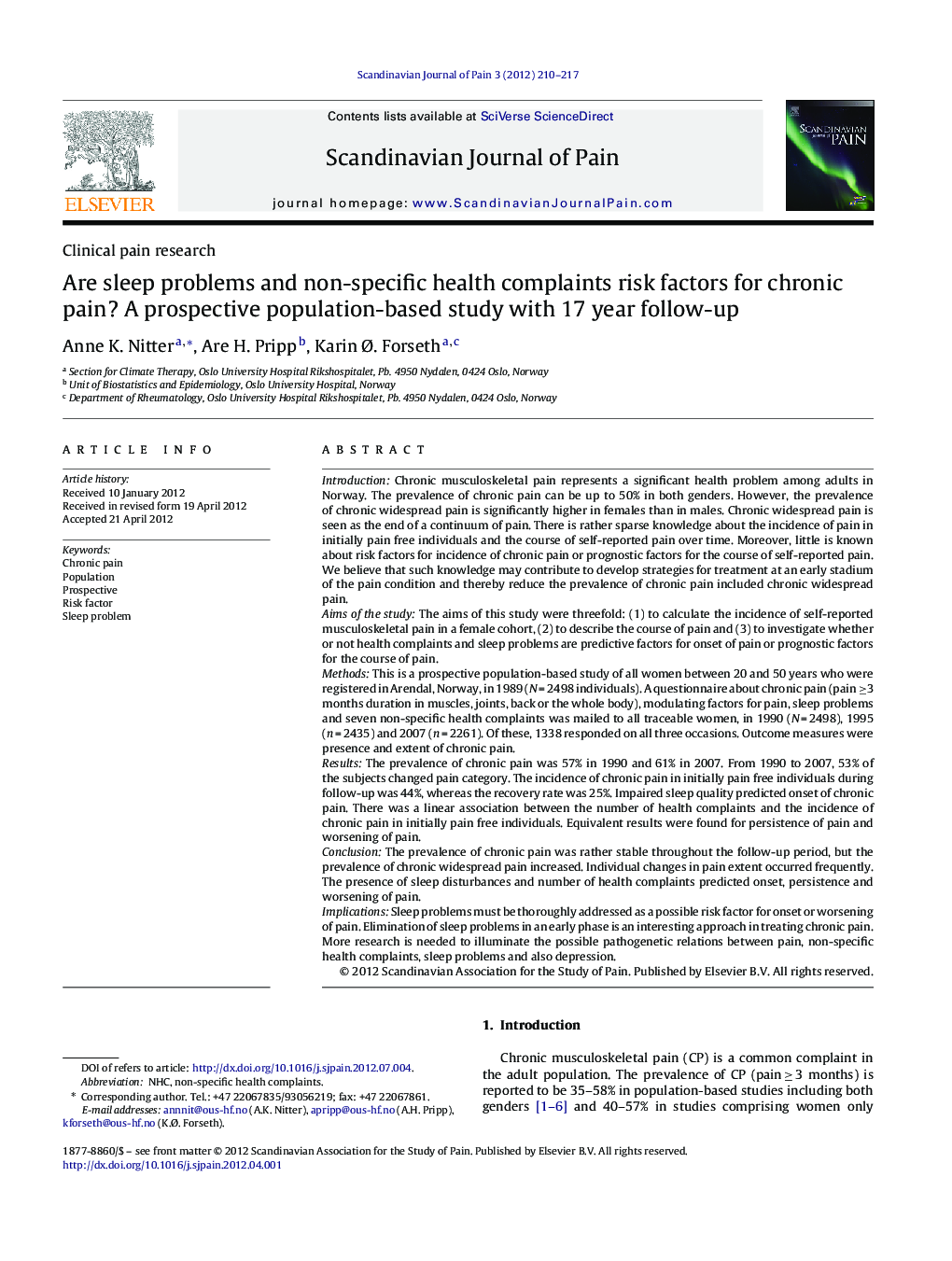| کد مقاله | کد نشریه | سال انتشار | مقاله انگلیسی | نسخه تمام متن |
|---|---|---|---|---|
| 2771025 | 1567823 | 2012 | 8 صفحه PDF | دانلود رایگان |

IntroductionChronic musculoskeletal pain represents a significant health problem among adults in Norway. The prevalence of chronic pain can be up to 50% in both genders. However, the prevalence of chronic widespread pain is significantly higher in females than in males. Chronic widespread pain is seen as the end of a continuum of pain. There is rather sparse knowledge about the incidence of pain in initially pain free individuals and the course of self-reported pain over time. Moreover, little is known about risk factors for incidence of chronic pain or prognostic factors for the course of self-reported pain. We believe that such knowledge may contribute to develop strategies for treatment at an early stadium of the pain condition and thereby reduce the prevalence of chronic pain included chronic widespread pain.Aims of the studyThe aims of this study were threefold: (1) to calculate the incidence of self-reported musculoskeletal pain in a female cohort, (2) to describe the course of pain and (3) to investigate whether or not health complaints and sleep problems are predictive factors for onset of pain or prognostic factors for the course of pain.MethodsThis is a prospective population-based study of all women between 20 and 50 years who were registered in Arendal, Norway, in 1989 (N = 2498 individuals). A questionnaire about chronic pain (pain ≥3 months duration in muscles, joints, back or the whole body), modulating factors for pain, sleep problems and seven non-specific health complaints was mailed to all traceable women, in 1990 (N = 2498), 1995 (n = 2435) and 2007 (n = 2261). Of these, 1338 responded on all three occasions. Outcome measures were presence and extent of chronic pain.ResultsThe prevalence of chronic pain was 57% in 1990 and 61% in 2007. From 1990 to 2007, 53% of the subjects changed pain category. The incidence of chronic pain in initially pain free individuals during follow-up was 44%, whereas the recovery rate was 25%. Impaired sleep quality predicted onset of chronic pain. There was a linear association between the number of health complaints and the incidence of chronic pain in initially pain free individuals. Equivalent results were found for persistence of pain and worsening of pain.ConclusionThe prevalence of chronic pain was rather stable throughout the follow-up period, but the prevalence of chronic widespread pain increased. Individual changes in pain extent occurred frequently. The presence of sleep disturbances and number of health complaints predicted onset, persistence and worsening of pain.ImplicationsSleep problems must be thoroughly addressed as a possible risk factor for onset or worsening of pain. Elimination of sleep problems in an early phase is an interesting approach in treating chronic pain. More research is needed to illuminate the possible pathogenetic relations between pain, non-specific health complaints, sleep problems and also depression.
► This is a prospective study with 17 years follow-up of an adult female cohort, n = 1338.
► Presence and locations of pain, sleep problems and non-specific health complaints are registered.
► Improvement or worsening of pain is frequent, widespread pain is most stable.
► The prevalence of widespread pain increased during the study period.
► Sleep disturbances and high numbers of nonspecific health complaints predict onset and worsening of pain.
Journal: Scandinavian Journal of Pain - Volume 3, Issue 4, October 2012, Pages 210–217